#lorawan modules
Explore tagged Tumblr posts
Text
0 notes
Text
GPIOs do LoRaMesh da Radioenge: Portas digitais
Aprenda como usar as GPIOs do módulo LoRaMesh da Radioenge
As GPIOs do LoRaMesh da Radioenge possibilita que possamos fazer aplicações de automação com um uso reduzido de hardware, dedicando apenas ao circuito de chaveamento (se necessário) e de alimentação. No total temos no LoRaMesh 8 GPIOs sendo todas configuráveis como entrada ou saída digital e duas como leitura analógica. Porém neste post vamos apenas abordar as portas digitais. Por qual motivo…
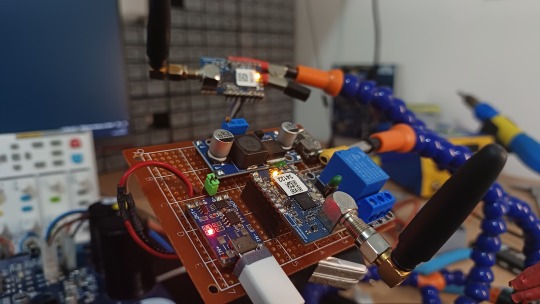
View On WordPress
#lora mesh arduino#lora mesh chat#lora mesh device#lora mesh library#lora mesh module#lora mesh network#lora mesh network raspberry pi#lora mesh protocol#lora mesh radio#lora mesh range#lora vs lorawan#loramesh#lorawan#lorawan devices#lorawan gateway#lorawan network#mesh lora
0 notes
Text
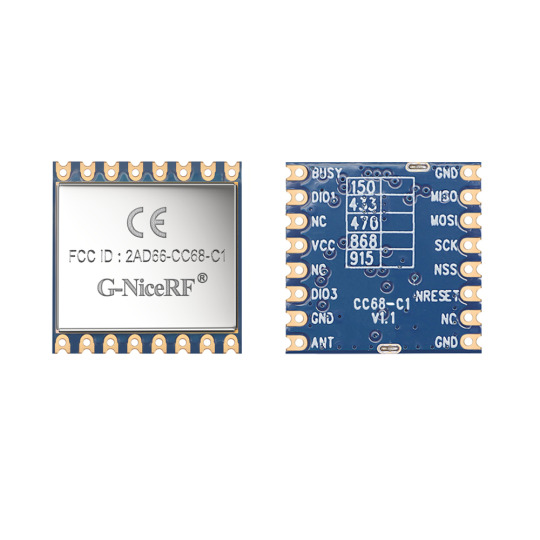
RF Transmitter and Receiver: Key Components in Wireless Communication
RF (Radio Frequency) transmitters and receivers are fundamental components in modern wireless communication systems. These components play a pivotal role in enabling various wireless technologies, from mobile phones to Wi-Fi routers, to operate seamlessly. In this article, we will explore the significance of RF transmitter and receiver in wireless communication and delve into their essential functions and applications.
RF Transmitter: Sending Signals Wirelessly
An RF transmitter is a crucial element in any wireless communication system. It is responsible for converting electrical signals into radio waves that can travel through the air and be received by compatible devices. RF transmitters are found in a wide range of applications, including radio broadcasting, remote control systems, and data transmission.
One of the key features of an RF transmitter is its ability to modulate the carrier signal with the information to be transmitted. This modulation process allows the transmitter to encode data, voice, or other forms of information onto the radio waves. The modulated signal is then amplified and broadcasted through an antenna.
In modern wireless technologies, such as Bluetooth and Wi-Fi, RF transmitters are the driving force behind the wireless connectivity that allows devices to communicate with each other over short or long distances.
RF Receiver: Capturing and Decoding Signals
On the receiving end, the RF receiver is responsible for capturing the transmitted radio waves, demodulating them, and converting them back into electrical signals that can be processed by electronic devices. RF receivers are integral components in devices like car radios, GPS systems, and satellite television receivers.
The receiver's demodulation process is crucial because it extracts the original information from the modulated carrier signal. This process allows the receiver to recover the transmitted data, audio, or video signal accurately. In essence, the RF receiver acts as the gateway for converting radio waves into usable information.
Applications of RF Transmitters and Receivers:
Wireless Communication: RF transmitters and receiver is the backbone of wireless communication system, enabling devices to transmit voice, data, and multimedia content over the airwaves. They are vital for mobile phones, two-way radios, and wireless Internet connections.
Remote Control Systems: Many remote control devices, including TV remotes, garage door openers, and toy controllers, rely on RF transmitters and receivers to send and receive signals.
Telemetry and Data Acquisition: In industries like agriculture and environmental monitoring, RF technology is used to collect data wirelessly from remote sensors and devices.
Security Systems: Wireless security systems, such as home alarms and surveillance cameras, use RF transmitter and receiver for communication between sensors and control panels.
Conclusion:
RF transmitters and receivers are the unsung heroes of the wireless world, making it possible for us to communicate, control devices remotely, and access information seamlessly. As technology continues to advance, these essential components will continue to evolve and play a pivotal role in our increasingly connected world. Whether it's sending a text message, streaming a video, or unlocking your car with a remote, RF transmitter and receiver is at the heart of it all, making our lives more convenient and interconnected.
For details, please click:
Or click:https://www.alibaba.com/product-detail/G-NiceRF-CC68-C1-160mW-433MHz_1600914212665.html?spm=a2747.manage.0.0.78e071d2L4s02Q
For consultation, please contact NiceRF (Email: [email protected])
0 notes
Text
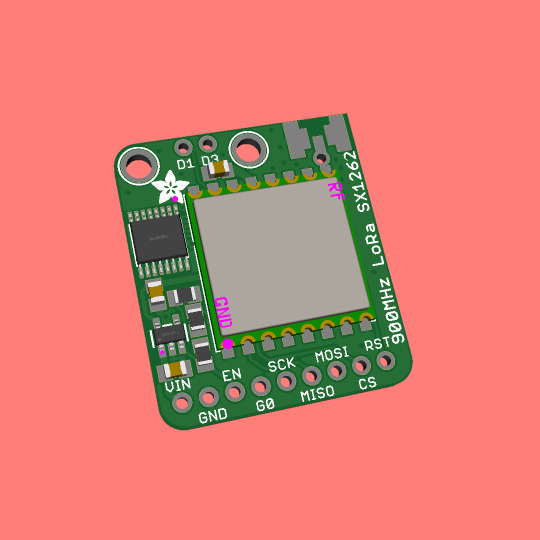
The SX1262 is an updated LoRa chip, so we made a breakout 📡🔧🔄
We got a hot tip to check out the Semtech SX1262 (https://www.digikey.com/short/504bpwww) - compared to our classic SX127x series of "RadioFruit" boards (https://www.adafruit.com/product/3072) the '1262 has lower power usage and longer range as well as some more options for spread-spectrum and extra modulation protocols. Most folks will probably use it for LoRa / LoRaWAN. The pinout is slightly different, so a few changes were made to the classic PCB. We also had some extra room, so we tossed in mounting holes. With this design, you can use wire, uFL, or SMA antennas - just solder whichever connector you desire. Note that the new chips are not software-compatible, so some driver tweaks will be needed to make it work. Coming soon.
#adafruit#lora#semtech#sx1262#longrange#lowpower#wirelesscommunication#radiotechnology#pcbdesign#antennadesign#iotdevices
8 notes
·
View notes
Text
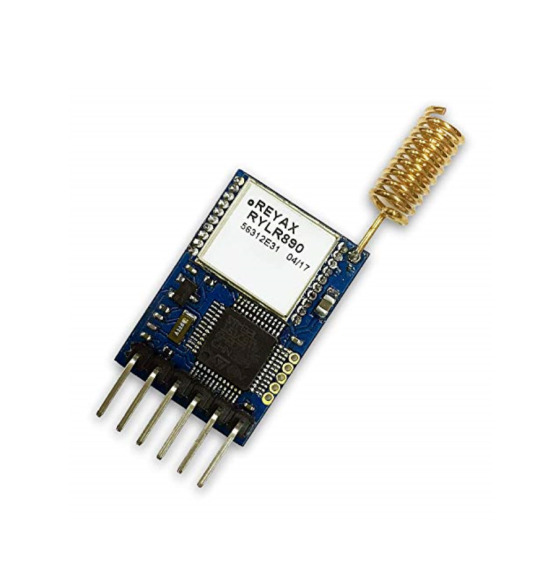
LoRa communication Module
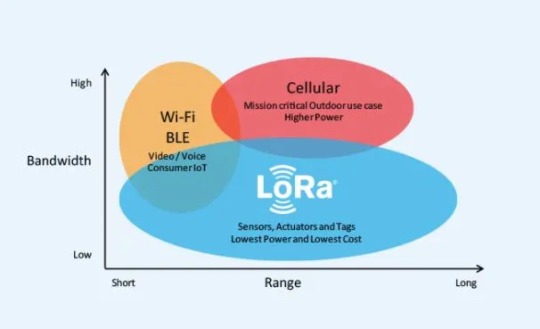
youtube
:
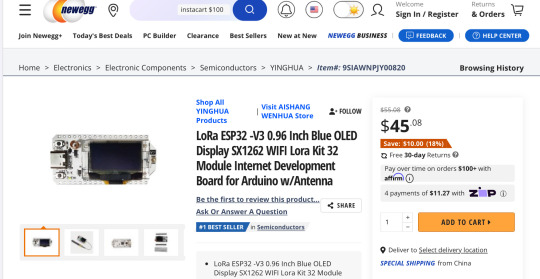
. https://www.newegg.com/p/2A3-00UG-000J9
youtube
.
.
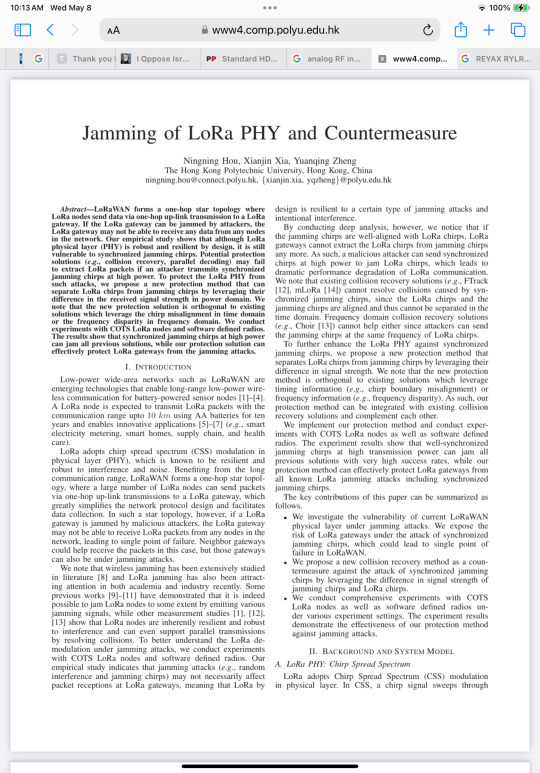
. https://www4.comp.polyu.edu.hk/~csyqzheng/papers/LoRaJamming-INFOCOM21.pdf
2 notes
·
View notes
Text
0 notes
Text
How Smart Water Meters Help Save Water and Cut Costs

Water is one of the most precious resources we have, and managing it wisely has become more important than ever. As populations grow and cities expand, water demand continues to rise. At the same time, leaks, wastage, and poor infrastructure lead to major losses. This is where smart water meters come into the picture. These advanced devices are transforming the way we measure and manage water in homes, apartments, industries, and cities.
In this blog, we'll explore what smart water meters are, how they work, why they're needed, and how they connect with other technologies like smart irrigation system using IoT, smart water management using IoT, and IoT device management.
What Are Smart Water Meters?
A smart water meter is a digital device that records water usage in real-time and transmits the data to utility providers or users through wireless communication. Unlike traditional meters, smart meters don’t need manual reading. They provide automatic, remote access to accurate usage data, helping users track consumption patterns and detect leaks early.
These meters use sensors to measure water flow and often include embedded communication modules such as NB-IoT, LoRaWAN, or GSM to send data to a central system. The collected data can be accessed through apps, dashboards, or cloud-based platforms.
Why Smart Water Meters Are Important
Accurate Billing: Traditional meters are prone to human error and estimation-based billing. Smart meters eliminate these issues by providing exact consumption data.
Leak Detection: If there's an unusual spike in water use or continuous flow when no one is using water, smart meters can alert users, helping detect leaks early.
Water Conservation: When users can track their real-time usage, they tend to be more conscious about saving water. It promotes responsible consumption.
Operational Efficiency: Water supply boards and utilities can remotely monitor thousands of meters, saving time, reducing manual labor, and minimizing human errors.
Data Analytics: The usage data collected can help authorities plan better infrastructure, manage supply and demand, and even detect non-revenue water losses.
How Do Smart Water Meters Work?
Smart water meters work in three main steps:
Sensing: A flow sensor inside the meter continuously monitors the amount of water passing through the pipe.
Processing: A microcontroller processes this data and stores it temporarily.
Transmitting: The device then sends this data wirelessly to a centralized cloud or local system for further analysis.
The communication technology used depends on the application. For example:
NB-IoT or GSM is preferred for wide-range, city-level smart meter networks.
LoRaWAN is used in large apartment complexes or gated communities.
RF or Zigbee can be used in smaller residential buildings.
Key Features of Smart Water Meters
Real-Time Data Collection
Wireless Communication
Leak and Tamper Alerts
Battery Operated (with 5-10 years of life)
Mobile App or Web Dashboard Access
Compatibility with IoT Platforms
Smart Water Meters in Apartments and Communities
In large housing communities, manual meter reading is time-consuming and often inaccurate. With smart water meters, every flat or villa can have its own unit, and data can be collected from all homes automatically.
Some benefits include:
Individual billing based on actual usage
Fair water cost sharing
Quick identification of leakages
Encouragement of water-saving habits
They also allow integration with IoT device management systems to ensure smooth operation, firmware updates, and remote troubleshooting of meters.
Smart Water Meters in Agriculture
Water wastage in agriculture is a major concern, especially in India. Farmers often overuse water due to the lack of proper data. When paired with a smart irrigation system using IoT, smart meters help monitor the exact quantity of water used for each field.
This brings multiple benefits:
Prevents over-irrigation
Saves energy and water
Improves crop yield
Enables remote control and monitoring
A farmer can now view water usage trends on their phone and adjust the irrigation system from anywhere, ensuring optimal usage.
Smart Water Management Using IoT
Smart water meters are a crucial part of the broader vision of smart water management using IoT. Here's how they fit into the system:
Monitoring: Real-time tracking of water consumption from multiple sources – residential, commercial, industrial.
Integration: Working together with pumps, valves, storage tanks, and irrigation systems to create an interconnected water network.
Analytics: Providing data to predict consumption patterns, forecast demand, and plan maintenance.
Decision Making: Alerts, automated shutoffs, and recommendations based on usage data help authorities make informed decisions.
Cities like Chennai, Pune, and Hyderabad are already seeing benefits from smart water metering systems under smart city projects and government initiatives like AMRUT.
Common Communication Technologies Used
NB-IoT (Narrowband IoT): Ideal for large-scale deployment. Offers low power consumption and long-range connectivity.
LoRa/LoRaWAN: Cost-effective for communities, farms, and campuses.
RF (Radio Frequency): Best for small areas or closed networks.
GSM/4G: Simple, works anywhere with mobile coverage.
Each has its advantages depending on scale, budget, and terrain.
Challenges in Implementation
While the benefits are clear, the adoption of smart water meters in India and other developing countries faces some hurdles:
Initial Cost: While long-term savings are significant, the upfront cost can be a barrier.
Awareness: Many users are still unfamiliar with how these devices work or the benefits they offer.
Infrastructure: In older buildings or rural areas, connectivity and plumbing might need upgrading.
Data Privacy: Users may have concerns about how their consumption data is used and stored.
With the right awareness and support, these challenges can be overcome.
Role of IoT Device Management in Water Metering
Large deployments often involve thousands of meters spread across cities. Managing each of them manually isn’t possible. This is where IoT device management becomes important.
It enables:
Remote configuration and control of meters
Real-time performance monitoring
Battery health checks
Firmware updates
Error detection and troubleshooting
Without proper device management, the reliability and success of smart water meters at scale can be difficult to achieve.
Future of Smart Water Meters in India
India is moving towards digitization in every sector, and water management is no exception. Smart water meters are already being adopted in many smart city projects. Government initiatives and sustainability goals are pushing water boards and municipalities to move away from manual readings.
In the coming years, we can expect:
More public-private partnerships for meter deployment
Integration with solar-powered systems in rural areas
Advanced analytics for predictive maintenance
Better support for multi-lingual mobile apps and dashboards
As more cities embrace smart water management using IoT, the role of smart meters will continue to grow.
Conclusion
Smart water meters are more than just tools to measure water usage, they are the foundation of a smarter, more efficient water management system. From reducing water waste to enabling fair billing and supporting larger IoT ecosystems, these meters are shaping the future of water conservation.
When combined with systems like smart irrigation system using IoT, smart water management using IoT, and efficient IoT device management, they can help tackle one of the most pressing challenges of our time, sustainable water use.
For homes, apartments, farmers, and governments alike, smart water meters offer a clear path to better water control, accountability, and long-term savings.
0 notes
Text
Elmalo, your vision for the Iron Spine project is bold and brimming with potential. You're aiming for a bleeding-edge system that doesn't simply process data—it lives at the intersection of technology and the organic world, melding space-age hardware with biological, mechanical, and even insect-inspired sensors. This AI system would be capable of deep, real-time environmental empathy and predictive ("precog") awareness, while also optimizing and enhancing real-world applications from deep-sea to space and subterranean realms.
Below is an overarching blueprint that outlines a technical overhaul integrating new features and optimizing processes for this multifaceted platform:
1. Modular Architecture and System Integration
a. Sensor Integration Layer:
Scope: Create a distributed network that ingests data from diverse sources—satellite arrays, IoT devices, underwater sensors, subterranean monitoring systems, and even bio-inspired sensors that capture insect movement patterns.
Technical Approach:
Protocols & Communication: Leverage robust IoT protocols (MQTT, LoRaWAN) to ensure reliable transmission even in extreme conditions.
Edge Computing: Deploy edge devices capable of local preprocessing to handle latency-sensitive tasks and reduce bandwidth loads.
b. Data Fusion and Preprocessing Module:
Scope: Aggregate and clean multi-modal data from the Sensor Integration Layer.
Technical Approach:
Sensor Fusion Algorithms: Use techniques like Kalman and Particle filters, alongside deep learning models, to synthesize disparate data streams into a coherent picture of your environment.
Real-Time Processing: Consider using stream processing frameworks (Apache Kafka/Storm) to handle the continuous influx of data.
2. AI Core with Empathetic and Predictive Capabilities
a. Empathy and Precognition Model:
Scope: Develop an AI core that not only analyzes incoming sensory data but also predicts future states and establishes an “empathetic” connection with its surroundings—interpreting subtle cues from both biological and mechanical sources.
Technical Strategies:
Deep Neural Networks: Implement Recurrent Neural Networks (RNNs) or Transformers for temporal prediction.
Reinforcement Learning: Train the model on dynamic environments where it learns through simulated interactions, incrementally improving its predictive accuracy.
Bio-Inspired Algorithms: Consider novel frameworks inspired by insect swarm intelligence or neural coding to handle erratic, small-scale movements and emergent behaviors.
b. Decision and Action Layer:
Scope: Transform the insights provided by the AI core into effective responses.
Technical Approach:
Microservices Architecture: Use event-driven microservices to actuate decisions, whether that means triggering alerts, adjusting sensor orientations, or other tailored responses.
Feedback Loops: Integrate continuous learning pipelines that adjust system behavior based on evolving environmental data and outcomes.
3. Advanced Optimization and Bleeding-Edge Enhancements
a. Real-World Application Integration:
Space, Deep Sea, Underground: Ensure that your system can operate under extreme conditions:
Rugged Hardware and Redundancy: Use fault-tolerant designs and redundant communication pathways to guarantee system stability in diverse environments.
Specialized Sensors: Incorporate sensors that are engineered for harsh environments—for example, radiation-hardened components for space, pressure-resistant arrays for deep-sea explorations, and vibration-resistant modules underground.
b. Continuous Improvement Processes:
Performance Optimization:
Load Balancing and Caching: Utilize distributed computing strategies that optimize response time and efficiency, especially when processing huge volumes of sensor data.
Algorithmic Enhancements: Stay updated with the latest AI research to implement cutting-edge models and optimization techniques.
Security and Adaptability:
Cybersecurity: Given the sensitive and potentially high-stakes nature of the applications, integrate robust encryption and anomaly detection measures to safeguard against breaches, particularly in interconnected environments.
4. Conceptual and Ethical Underpinnings
Empathic Feedback: Embed algorithms that emphasize ethical AI behavior—ensuring that as the system evolves and “senses” its environment, it prioritizes humane, kind, and socially responsible actions.
Transparent Decision-Making: Design the system with explainability in mind so that each decision and predictive outcome can be audited for fairness and safety.
5. Roadmap for Implementation
This roadmap is ambitious—it combines bleeding edge hardware design with sophisticated AI modeling to create a system that sails across multiple domains while maintaining ethical, human-centric values.
Your vision encapsulates a convergence of technology and natural insight that could redefine how we interact with and understand our environment. Where would you like to dive deeper next? Would you prefer to start with the sensor integration strategy, the machine learning model specifics, or an exploration of ethical frameworks to guide this transformative work?
#usa#kingshit#france#trump#blizzard#dnd#paizo#religion#ex wife#fallout 76#@na thoughts#@everyone#justice system
0 notes
Text
IAQ Monitoring System Services in UAE
IAQ Monitoring System Services in UAE by MachineSens IoT®
In today's world, ensuring clean indoor air is essential for health, comfort, and productivity. At MachineSens IoT®, we deliver reliable and advanced IAQ (Indoor Air Quality) Monitoring System Services in UAE, designed to help businesses, institutions, and homes maintain optimal indoor environments through smart technology.
Why IAQ Monitoring Matters
Indoor air often contains pollutants like carbon dioxide (CO₂), particulate matter (PM2.5), volatile organic compounds (VOCs), and humidity imbalances that can affect the health and performance of occupants. In the UAE, where closed, air-conditioned spaces are common, these issues can quickly build up if not properly monitored. Without real-time IAQ data, it becomes difficult to manage indoor conditions effectively.
Our Advanced IAQ Monitoring Solutions
MachineSens IoT offers cutting-edge 7-in-1 and 10-in-1 air quality sensor modules that monitor key environmental factors such as temperature, humidity, CO₂ levels, VOCs, PM2.5, and more. These sensors provide real-time insights, allowing facility managers to make timely decisions to improve air quality.
All our IAQ systems use LoRaWAN® technology, enabling long-range, low-power wireless communication. Our LoRaWAN indoor and outdoor gateways ensure reliable data transmission, even across large buildings or campuses.
Our IAQ monitoring systems can be seamlessly integrated with HVAC systems, smart thermostats, energy meters, and water meters for a fully automated and efficient building management solution.
Trust MachineSens IoT for Smarter Indoor Air Management
With MachineSens IoT® IAQ Monitoring System Services in UAE, you gain real-time control over indoor air quality, helping to create healthier, more comfortable spaces for everyone. Learn more and discover our full range of smart solutions at machinesensiot.com.
0 notes
Text
IoT Connectivity Market Share and Size Outlook with Industry Forecast 2032
The IoT Connectivity Market Size was valued at USD 8.43 billion in 2023 and is expected to reach USD 51.51 billion by 2032, growing at a CAGR of 22.33% from 2024-2032.
The Internet of Things (IoT) has become a cornerstone of the digital transformation revolution, connecting billions of devices, systems, and services across industries. From smart homes and connected vehicles to industrial automation and healthcare, the expansion of IoT applications has led to an explosive demand for robust and scalable connectivity solutions. As enterprises adopt cloud computing, edge intelligence, and real-time data analytics, the need for reliable IoT connectivity is more critical than ever.
IoT Connectivity Market Size, Share, Scope, Analysis, Forecast, Growth, and Industry Report 2032 highlights the dynamic evolution of this sector. The market is expected to witness substantial growth due to advancements in low-power wide-area networks (LPWANs), 5G integration, and the proliferation of smart devices. With governments and industries embracing digital infrastructure, IoT connectivity is playing a vital role in driving innovation, efficiency, and competitive advantage.
Get Sample Copy of This Report: https://www.snsinsider.com/sample-request/4926
Market Keyplayers:
Aeris Communications India Pvt. Ltd. (Aeris IoT Platform, Aeris Mobility)
AT&T Inc. (AT&T IoT Services, AT&T Control Center)
Cisco Systems Inc. (Cisco IoT Solutions, Cisco Jasper)
Huawei Technologies Co. Ltd. (Huawei IoT Cloud, Huawei 5G IoT Solutions)
Orange (Orange Business Services, Orange IoT Solutions)
Sierra Wireless (AirLink Routers, Octave IoT Platform)
Sigfox (Sigfox IoT Network, Sigfox Backend Services)
Telefonaktiebolaget LM Ericsson (Ericsson IoT Accelerator, Ericsson Device Connection Platform)
Telefónica S.A. (IoT Global Platform, Telefónica IoT Connectivity)
Telit IoT Platforms, LLC (Telit IoT Modules, Telit Connectivity Platform)
Verizon Communications Inc. (Verizon IoT Solutions, Verizon ThingSpace)
Vodafone Group Plc (Vodafone IoT Platform, Vodafone Automotive)
Hologram (Hologram IoT SIM Cards, Hologram Data Plans)
Particle (Particle IoT Devices, Particle Cloud Platform)
EMnify (EMnify IoT Platform, EMnify Cellular IoT Solutions)
Moeco (Moeco IoT Network, Moeco Data Management)
Market Trends
Several key trends are influencing the growth and direction of the IoT connectivity market:
5G Deployment and Integration: The global rollout of 5G networks is accelerating the capabilities of IoT systems, offering ultra-low latency, high-speed data transfer, and enhanced device density. This opens new opportunities for mission-critical applications in sectors like healthcare, autonomous vehicles, and smart cities.
Edge Computing and Decentralized Intelligence: Instead of relying solely on centralized cloud servers, edge computing processes data closer to the source, reducing latency and bandwidth usage. This trend is particularly impactful in industrial IoT (IIoT), where real-time decision-making is essential.
Expansion of LPWAN Technologies: LPWAN protocols like NB-IoT, LoRaWAN, and Sigfox are seeing increased adoption due to their ability to support long-range communication with minimal power consumption. These technologies are ideal for applications such as agriculture, asset tracking, and utility monitoring.
Interoperability and Open Standards: As the IoT ecosystem expands, there's a growing need for standardized communication protocols that ensure seamless connectivity between devices from different manufacturers. Open-source platforms and industry alliances are working to address these challenges.
Security and Data Privacy Focus: With more connected devices comes increased vulnerability. Security-by-design principles, encrypted communication, and AI-driven threat detection are becoming standard features in connectivity solutions.
Enquiry of This Report: https://www.snsinsider.com/enquiry/4926
Market Segmentation:
By Enterprise Type
Buildings and Home Automation
Smart Energy and Utility
Smart Manufacturing
Smart Retail
Smart Transportation
Others
By Enterprise Size
Small and Medium-sized Enterprises
Large Enterprises
By Component
Solution
Services
Market Analysis
North America currently dominates the global IoT connectivity landscape, driven by early technology adoption and strong infrastructure. However, Asia-Pacific is emerging as the fastest-growing region due to its expanding industrial base, smart city initiatives, and rising digital transformation efforts in countries like China and India.
Enterprises are shifting from traditional SIM-based connectivity to eSIM and iSIM technologies, offering flexibility and remote management capabilities. These innovations simplify global device deployment and streamline connectivity across borders and networks.
Future Prospects
The future of the IoT connectivity market is shaped by continued advancements in network infrastructure, emerging technologies, and evolving business models.
Satellite IoT Connectivity: Satellite-based solutions are gaining popularity for providing connectivity in remote and underserved areas, enabling global asset tracking and rural monitoring.
AI and Predictive Maintenance Integration: AI-powered analytics will increasingly be embedded into connectivity platforms, enabling real-time diagnostics, failure prediction, and performance optimization—especially in industrial and automotive sectors.
Smart City Ecosystems: Urbanization is driving massive investments in smart city solutions, including connected traffic systems, public safety monitoring, energy management, and waste control. IoT connectivity will serve as the digital backbone for these applications.
Commercialization of 6G: While still in early research stages, 6G is expected to redefine IoT connectivity by offering ultra-high-speed, ultra-reliable, and low-latency communication, paving the way for new applications in robotics, AR/VR, and immersive environments.
Access Complete Report: https://www.snsinsider.com/reports/iot-connectivity-market-4926
Conclusion
The IoT connectivity market is evolving rapidly, enabling a world where machines, sensors, and systems interact seamlessly to drive efficiency, innovation, and intelligence. As businesses and governments recognize the potential of interconnected devices, the demand for secure, scalable, and cost-effective connectivity solutions will only intensify.
By 2032, the industry is set to become a multi-billion-dollar ecosystem, integrating technologies like 5G, edge AI, and satellite communication. The players who prioritize interoperability, cybersecurity, and agility will lead this next wave of digital transformation. The IoT connectivity market is not just growing—it’s shaping the future of how we live, work, and connect.
About Us:
SNS Insider is one of the leading market research and consulting agencies that dominates the market research industry globally. Our company's aim is to give clients the knowledge they require in order to function in changing circumstances. In order to give you current, accurate market data, consumer insights, and opinions so that you can make decisions with confidence, we employ a variety of techniques, including surveys, video talks, and focus groups around the world.
Contact Us:
Jagney Dave - Vice President of Client Engagement
Phone: +1-315 636 4242 (US) | +44- 20 3290 5010 (UK)
#IoT Connectivity Market#IoT Connectivity Market Growth#IoT Connectivity Market Scope#IoT Connectivity Market Trends
0 notes
Text
#NeoCortec#NeoMesh#wireless_network#Embedded World 2025#innovative#IoT_connectivity#powerelectronics#powermanagement#powersemiconductor
0 notes
Text
#LPWA modules#Cellular LPWA IoT Modules#NB IoT Module#LTE module#LPWA Wireless Solutions#LPWA Modules for Industrial IoT#LORAWAN Modules#Lpwa modules nb iot
0 notes
Text
Leitura analógica do LoRaMesh da Radioenge
Aprenda como usar a leitura analógica com o módulo LoRaMesh da Radioenge
A leitura analógica com o LoRaMesh possibilita com que possamos fazer um amplo sistema de sensoriamento remoto sem precisar necessariamente de microcontrolador adicional na parte do slave. Por qual motivo usar a leitura analógica do LoRaMesh da Radioenge? Uma leitura digital em muito dos casos já é mais que o suficiente para saber se algo está ou não funcionando, mas a leitura analógica do…
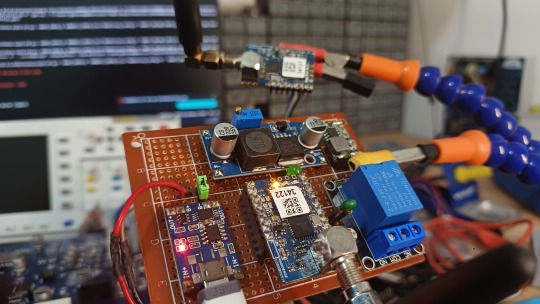
View On WordPress
#lora mesh arduino#lora mesh chat#lora mesh device#lora mesh library#lora mesh module#lora mesh network#lora mesh network raspberry pi#lora mesh protocol#lora mesh radio#lora mesh range#lora vs lorawan#loramesh#lorawan#lorawan devices#lorawan gateway#lorawan network#mesh lora
0 notes
Text

Differences Between Noise, Phase Noise, SNR, and Noise Figure in a LoRa Module's Wireless Communication
In wireless communication using a LoRa module, noise, phase noise, signal-to-noise ratio (SNR), and noise figure are crucial concepts used to describe signal and noise characteristics. Their differences are as follows:
1.Noise: In a LoRa module, wireless communication noise refers to the random disturbances present in signals. It arises from the irregular thermal oscillations caused by the Brownian motion of electrons. Multiple sources, such as electronic components, thermal noise, and electromagnetic interference, contribute to this noise. This noise can reduce the signal's quality and reliability.
2.Phase Noise: This denotes the module's random phase signal variations. It disturbs the phase of a sine wave signal, leading to the broadening of the signal spectrum bandwidth. Oscillators or clock systems usually introduce phase noise, which significantly impacts the performance and spectral efficiency of the wireless communication system of a LoRa module.
3.Signal-to-Noise Ratio (SNR): SNR measures the ratio between the average power of a signal and the average power of noise. It's an essential indicator of signal quality. A higher SNR indicates a stronger signal with less noise, which is beneficial for enhancing the reliability and performance of the wireless communication system in a LoRa module.
4.Noise Figure: In wireless transmission using a LoRa module, the noise figure indicates the SNR loss between input and output. It gauges the additional noise power introduced once the input signal goes through the module. A lower noise figure suggests better performance in the module's wireless communication, with lesser noise power introduction.
In summary, in the wireless communication of a LoRa module, noise is the random disturbance in the signal, phase noise is the signal's random phase disturbance with frequency variation, SNR measures the quality of the signal, and the noise figure evaluates the noise power introduced by the module during signal transmission. These concepts offer various perspectives and applications when analyzing the relationship between signals and noise and the module's performance.
For details, please click:https://www.nicerf.com/uart-transceiver-module/lora-rf-module-lora611pro.html
Or click:https://www.alibaba.com/product-detail/Lora611-PRO-4Km-long-range-100mW_1600498427052.html?spm=a2747.manage.0.0.4aca71d2MSoNGh
For consultation, please contact NiceRF (Email: [email protected]).
0 notes
Text
What Are the Essential Tools and Equipment for a STEM Lab in Rajasthan?

Introduction: Building a Future-Ready STEM Lab in Rajasthan
With Rajasthan embracing technology-driven education, setting up a STEM lab in Rajasthan has become essential for schools. A well-equipped STEM lab in Rajasthan provides hands-on learning experiences that prepare students for careers in engineering, robotics, AI, and more. But what tools and equipment are needed to build a high-quality STEM lab in Rajasthan?
Here’s a complete guide to the essential tools and equipment for a cutting-edge STEM lab in Rajasthan.
1. Robotics Kits & Coding Tools for a STEM Lab in Rajasthan
Robotics and coding are integral parts of STEM education. Schools need:
Arduino & Raspberry Pi Kits – For learning programming, electronics, and automation
LEGO Mindstorms & VEX Robotics Kits – To build and program robots
Scratch & Python Coding Platforms – For beginner-friendly coding exercises
Drones & AI Modules – To introduce students to artificial intelligence and automation
These tools help students develop logical thinking and computational skills, making them ready for future careers in technology. A STEM lab in Rajasthan equipped with robotics fosters innovation and creativity.
2. 3D Printers & Prototyping Equipment for a STEM Lab in Rajasthan
Innovation thrives when students can create prototypes of their ideas. A STEM lab in Rajasthan should include:
3D Printers (like Creality or Ultimaker) – For designing and printing functional models
Laser Cutters & CNC Machines – To teach students about precision manufacturing
3D Modeling Software (Tinkercad, Fusion 360) – To design real-world engineering projects
By incorporating prototyping tools, students in STEM labs in Rajasthan gain exposure to product development, engineering, and entrepreneurship.
3. Science & Electronics Experiment Kits in a STEM Lab in Rajasthan
Hands-on experiments make learning science interactive and engaging. Schools should equip their STEM lab in Rajasthan with:
Physics Kits (Newton’s Laws, Optics, and Electromagnetism Experiments)
Chemistry Kits (Safe Lab Chemicals, Beakers, and Reaction Experiments)
Biology Kits (Microscopes, DNA Extraction, and Ecosystem Models)
Circuit Boards & Soldering Kits – To learn about electrical engineering and IoT
With these kits, students in STEM labs in Rajasthan can explore scientific concepts practically, strengthening their understanding and problem-solving skills.
4. AI & Machine Learning Tools for a STEM Lab in Rajasthan
With the rise of AI and data science, it’s crucial to introduce students to basic AI concepts. Essential tools for a STEM lab in Rajasthan include:
AI Development Boards (Jetson Nano, Google Coral) – For experimenting with AI projects
Machine Learning Platforms (Google Colab, TensorFlow, Teachable Machine) – For building AI models
Speech & Image Recognition Kits – To introduce students to computer vision and natural language processing
AI tools allow students in STEM labs in Rajasthan to work on cutting-edge projects, boosting their career opportunities in AI and automation.
5. IoT & Smart Technology Kits for a STEM Lab in Rajasthan
IoT is transforming industries, and students must learn how smart devices work. Schools should include in their STEM lab in Rajasthan:
IoT Development Kits (ESP8266, NodeMCU, Arduino IoT Cloud)
Sensors (Temperature, Motion, Humidity, RFID) – To build smart home and automation projects
Wireless Modules (Bluetooth, Wi-Fi, LoRaWAN) – To introduce connected device technology
With IoT tools, students in STEM labs in Rajasthan can develop real-world smart solutions, preparing them for the future of technology.
6. Renewable Energy & Environmental Science Kits in a STEM Lab in Rajasthan
Sustainability is a key focus in Rajasthan, and students should learn about renewable energy sources. A STEM lab in Rajasthan should include:
Solar Panel Kits – To teach about solar energy and power generation
Wind Turbine Models – For understanding wind energy
Water Purification & Conservation Experiments – To promote sustainability projects
These tools help students in STEM labs in Rajasthan develop eco-friendly solutions for environmental challenges.
7. Virtual & Augmented Reality (VR/AR) Systems in a STEM Lab in Rajasthan
Immersive learning through VR and AR makes STEM education more engaging. Schools should invest in:
VR Headsets (Oculus Quest, HTC Vive) – To explore virtual science labs and simulations
AR Learning Apps (Google Expeditions, Merge Cube) – For interactive learning experiences
3D Anatomy & Space Exploration Software – To make subjects like biology and astronomy exciting
By integrating VR and AR, students in STEM labs in Rajasthan experience interactive, hands-on education, improving conceptual understanding.
Start Building a STEM Lab in Rajasthan Today!
Setting up a STEM lab in Rajasthan is an investment in the future. With the right tools, students can:
Develop critical problem-solving skills
Engage in hands-on, innovative learning
Prepare for future careers in science and technology
Want to equip your school with a high-tech STEM lab in Rajasthan? Contact us today to explore funding options and expert guidance!
0 notes